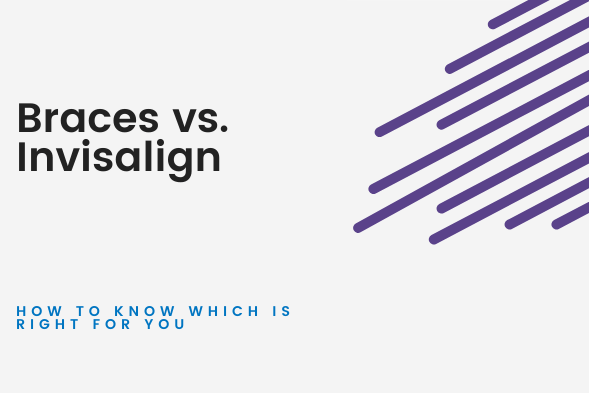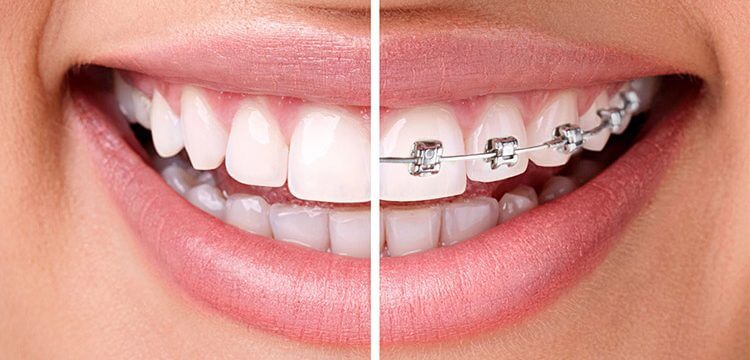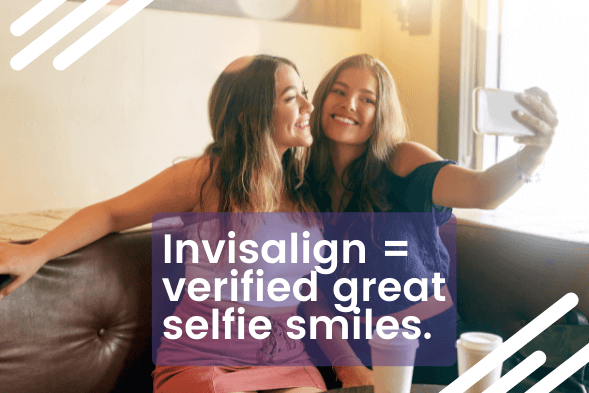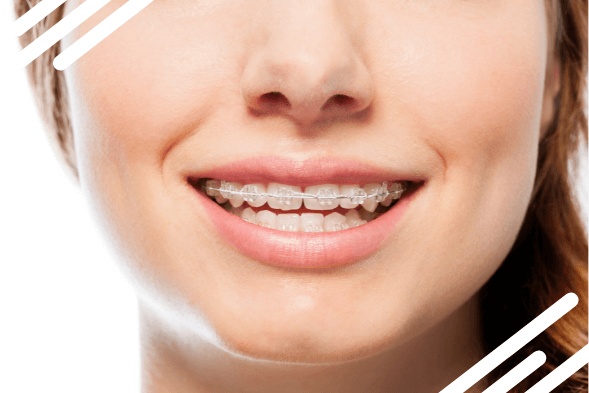
Everywhere you look online there’s a different take on the Invisalign vs. traditional braces debate. So, what’s the truth? And which treatment option is right for you?
It can be challenging to decipher what’s real and what’s biased when it comes to info online about Invisalign aligners and traditional braces.
With so many varying opinions and options out there, it’s tough to be sure you’re making the best decision for your smile. It’s hard to find information you can trust, so we want to help. We’re a local metropolitan Phoenix orthodontic practice that has been straightening teeth and helping patients get (and keep!) their winning smiles for over 25 years.
Many places that write about the pros and cons of Invisalign vs. braces have little experience with either, and they don’t offer both to patients – but we do. So, we want to help you through the decision process to find the option that’s truly best for you.
So, here is your 2023 Guide to Braces vs. Invisalign.
Get the answers about treatment costs and everything else you need to know about braces and Invisalign clear aligners. When you finish, you’ll have the info you need to make the best decision about your orthodontic treatment.
Braces vs. Invisalign Comparison Chart
| BRACES | INVISALIGN | |
|---|---|---|
| Cost | Can range from: $1,800 – $10,000 Typical Quality Treatment: $6,000 – $10,000 | Can range from: $2,000 – $10,500 Typical Quality Treatment: $6,000 – $10,000 |
| Insurance Coverage | Yes, if you have it (On average, $1000) | Yes, if you have it (On average, $1000) |
| Case Complexity | Essentially any case complexity | Essentially any case, if the doctor is experienced |
| Treatment Length | 12-20 months (at Dickerson Orthodontics). 24 months (industry average) | 12-20 months (at Dickerson Orthodontics). 24 months (industry average) |
| Start Time | Can be in your first visit | 6-8 weeks after you say ‘yes’ |
| Removability | Not removable | Removable |
| Compliance | Easy to comply automatically | Up to you to comply |
| Appointments | Varies by doctor. 15 or fewer at Dickerson Orthodontics. Industry average = 22 appts | Varies by doctor. Usually a couple less than braces. |
| In-Person Expert Oversight | Required regularly | Less essential |
| Discomfort | Mild discomfort after appointments | Mild discomfort with each new aligner (at beginning) |
| Appearance | Can be more discreet than braces used to be, but still visible | Essentially invisible at normal conversational distances |
| Hygiene | Requires special effort to brush + floss | Simple – normal brushing and flossing routine |
| Food/Drink Limitations | Avoid hard and sticky foods | No limitations |
| Other Benefits | Continual progress because they’re never removed. Multiple types of braces to fit your needs. Braces can be clear. | Good for patients who clinch, grind, or have TMJ. More professional looking for working adults. You can whiten teeth during treatment. |

Why offer both Traditional Braces and Invisalign?
We offer both braces treatment and Invisalign treatment at Dickerson Orthodontics because each has unique advantages for families seeking orthodontic treatment.
There are times when braces are the best fit for a patient. If you want to start treatment quickly and see changes fast, braces are usually the way to go.
Other times, Invisalign is best. If remembering to wear Invisalign is easy for you, or you prefer being able to remove your Invisalign trays and not having eating restrictions, Invisalign is ideal.
Invisalign treatments also include custom-made aligners that are virtually invisible even at normal conversational distances. Appointments with Invisalign can be less frequent and much more flexible, too. We often even have virtual appointments with our Invisalign patients when in-person isn’t possible.
Invisalign can make brushing and flossing easier vs. braces, but it’s also much easier to remember to wear braces for younger patients. The pros and cons of each treatment option are real and valuable. Both traditional braces and Invisalign do an excellent job of straightening teeth.
We believe that owning a winning smile ought to be available to everyone, so another reason we offer both for orthodontic treatment is that braces cost can be more affordable for some cases than Invisalign costs – but keep reading to make sure that applies to you!
During your initial free consultation, we’ll talk with you and understand your situation and help you determine which treatment – braces or Invisalign – is the right fit for you.
Advantages of Braces (Traditional Metal Braces, Ceramic Braces, Lingual Braces)
How do you know if braces are right for you? Only trust an answer from a doctor who has actually seen your smile. Experienced orthodontists are aligning teeth for a living and can see things in person that just don’t come across in even a high-resolution photo.
The good news is that a consultation with a world-class doctor in Phoenix doesn’t have to cost you anything, at Dickerson Orthodontics our initial consultations are totally free.
Be skeptical of anyone that gives you an answer before seeing your teeth in person. And watch out for anyone who places you in a predetermined treatment category just based on a few general survey questions.
The doctor you want for braces or Invisalign treatment will help you understand the difference between metal and ceramic braces, or lingual and ceramic braces, and they’ll tell share with you the pros and cons of each one.
But there are some characteristics that are usually true for people who are a great fit in general for conventional braces. Here they are.
Time is of the essence
If you want to start treatment right away for whatever reason, traditional braces might be the right fit. It can take up to 6-8 weeks for us to get Invisalign aligners back after your free initial consultation (usually it’s closer to 6 weeks).
Often with braces treatment, we can have brackets attached and rubber bands on in the very same appointment as your initial consult. So from the moment you say ‘yes’ to treatment with us, braces can get you started about 6-8 weeks faster than your Invisalign treatment would be ready to begin.
Compliance is a concern
Let’s be honest, we’d all rather have a perfect smile without putting in the work or having any extra to-dos. So remembering to wear your clear aligners consistently can be a challenge for some kids and teens.
What your kids will love is being done sooner. And the number one thing that drags out the average treatment time for our patients is compliance and not following our recommendations.
Traditional braces make compliance easy in many respects. You can’t take them out and they are always at work improving your smile, 24/7. By making compliance easy, it greatly reduces the risk of longer treatment time (and more expenses).
It’s great for your kids – who get their winning smile faster – and it usually costs a little less than Invisalign aligners and other clear aligner brands, too.
Cost of orthodontic care
You might be surprised to hear that there’s not nearly as big a difference in cost for Invisalign vs. braces as many people believe. Today, braces & Invisalign are very comparable in price for most cases.
But after factoring in lab fees for Invisalign, Invisalign treatment can tend to cost a little more. And for some families, a little bit cheaper can make a big difference. In these cases, metal braces might be the ideal fit for you.
Find an orthodontist who will give you clear answers to your cost questions, and a specific price. Even better if they give you a price for both Invisalign and braces so you can compare for yourself.
Generally speaking, braces are usually a better fit for tight budgets, but make sure you verify that for yourself. It’s worth it.
Advantages of Invisalign vs. Braces
It’s worth repeating: the only complete answer is from a doctor who’s seen your smile.
Here are some of the general characteristics that are often true of people who are a great fit for Invisalign treatment.
More flexibility during orthodontic treatment
Appointments with Invisalign are a little less frequent and much more flexible.
For any patients that are frequently out of town or live out of state, we even do Invisalign appointments virtually. If you travel a lot or know that you have significant travel during your treatment, this may make Invisalign a great fit for you.
Fewer appointments
Patients at Dickerson Orthodontics enjoy a lot fewer appointments than at typical orthodontists in Phoenix.
During your treatment, a braces patient at Dickerson Orthodontics will have 15 or fewer appointments total than average patients. That’s significantly less than the industry average of 24.
But it gets better. For Invisalign, it is often a couple fewer appointments less than whatever your braces amount would be for your particular case. Now that’s an advantage!
For clinching, grinding, or TMJ
If you’re a clincher, grinder, or experience TMJ, then Invisalign treatment is often the better choice for you. The Invisalign trays naturally work as a comfortable prevention and protection measure in your mouth. Another advantage to wearing your Invisalign as much as possible.
Precision and/or minor cases
Clear aligners make it easier to do fine-precision tuning because each aligner is predetermined into very specific placements.
Braces, on the other hand, rely more on tweaking and seeing where things are; adjusting as you go. If you’re looking for a perfected smile or simply have a very minor case, this may make Invisalign or one of the other clear aligners from us a good fit for your needs.

Appearance and convenience
This is the attribute of Invisalign that gets a lot of press, and rightfully so. Invisalign uses essentially invisible aligners that are nearly impossible to see at normal conversation distances – a huge asset for many working professionals, unlike braces.
For some professionals, this is even a requirement – think actors, models, and other similar professions. In these cases, Invisalign is a much better fit.
For others, the convenience of Invisalign has more to do with how little you have to adjust to your daily life during treatment. Invisalign is completely removable, so there are no limitations on what you can eat and drink like there are with braces.
You can keep your normal diet and keep on drinking your morning coffee/tea, or evening wine without any fear of staining your aligners. They can even help protect you from tooth decay because it’s so much easier to clean your teeth during treatment.
It’s a very nice advantage to going with Invisalign treatment.
Invisalign vs. Braces: What Are the Benefits?
Now that you have a handle on the general reasons why braces or Invisalign might be the best fit for you, we’re going to give you another tool to go in your arsenal. Here is a side-by-side comparison of all the major factors that patients tell us play a big role in their treatment decisions.
Read on and see exactly how braces and Invisalign stack up against each other for each factor.
Cost & Dental Insurance
Generally speaking, the cost of Invisalign and braces is actually quite comparable. In the earlier days of Invisalign aligners, the price differential between the two was much more significant than it is today. It used to be that Invisalign was priced truly well above braces.
Now, it’s more accurate to say they’re in the same tier – Invisalign costs are just a little more in many cases after factoring in lab fees for Invisalign.
If you have orthodontic coverage through your insurance plans or health savings accounts, it will pay out the same for both braces and Invisalign.
In the United States, the average insurance plan coverage is about $1000. Some people might get up to $1500, but that is rarer. (Sadly, the amount dental insurance plans cover hasn’t changed at all since 1970.)
Advantage: Braces
The Real Way to Save on Costs
While we’re talking cost, here’s a pro tip for you: the best way to save on costs isn’t by choosing braces. That may save you a little, but it’s going to be a marginal difference for most people. There’s a way you can save a lot more on your treatment, and most orthodontists won’t ever mention it to you.
Here it is: choose an orthodontist who is committed to reducing your number of appointments and increasing how fast you finish treatment with the same great smile.
The faster you finish treatment, the fewer appointments you’ll need. And the fewer appointments you’ll need, the less costly it’ll be for you. Each extra appointment costs you money and time. The more appointments, the more school and work that is missed, and that costs you money.
Also – the longer a person is in treatment, the greater the chance of white spots developing on teeth. So faster treatment is better and more cost-effective.
Our recommendation – avoid all the noise around the cost of metal braces or lingual braces or clear aligners and find an orthodontist who can get you a winning smile simpler and faster.
Treatment Time
This one is a little tricky. When you look online at other guides, you’ll either find a lot of conflicting time frames or really big ranges – or both. These sources aren’t lying to you, this is a complex question to answer.
There are two big reasons treatment time is such a challenging factor to nail down clearly.
The first is that a large part of treatment length is determined by patient compliance and following doctor recommendations. As you could imagine, there’s a large range of compliance when it comes to treatment – both for braces and Invisalign. It’s much easier in many ways to comply automatically with braces treatment, so they get the advantage here over Invisalign.
The second reason – treatment length varies dramatically from doctor to doctor. Some patients assume that braces and Invisalign both have a one-size-fits-all type of process, but they don’t.
Here’s an example. The average treatment length in the United States today is 24 months (or 2 years). That’s the average, so there are many cases that go much longer than that.
In comparison, we start nearly all of our patients out with the goal of finishing treatment in 1-2 years. So 22-24 months is the longest we want to see a treatment go.
Many of our patients finish in closer to 12 months – just 1 year. That’s half the time of the average orthodontic case in the United States. That’s a big difference.
If we were to just put that information in a table, or give you a big range, you’d find it at best to be not very helpful. Most Invisalign and Braces guides online don’t take the time to explain this to you. Find a doctor who does.
So, which one is faster?
Invisalign can be quite a bit faster in particular cases – mostly dealing with minor movements or precision cases. The longer your treatment plan requires to reach your winning smile, the more clear aligners have a speed advantage there as well.
There is one catch, though. From the moment you say ‘yes’ to treatment, it may take 6-8 weeks for us to get your Invisalign back from the lab so you can start treatment.
So, while Invisalign is faster in many cases from the moment you actually start treatment, braces can be faster overall from the moment you say ‘yes’ for standard-length cases. If time is of the essence to you, ask your doctor specifically about the treatment length in your case.
Advantage: Invisalign, probably, but it might be different for you
(Also, this is assuming in both cases that you are compliant with braces, wear your Invisalign aligners, maintain good hygiene, and follow your doctor’s recommendations. Compliance has a huge impact on treatment length.)
Number of Appointments
Here again, you might see a wide range of answers to this question online.
At Dickerson Orthodontics, you are the real winner regardless of whether you go with braces or Invisalign. You enjoy far fewer appointments than you would at most other practices. It’s a win-win either way.
However, Invisalign patients do enjoy slightly fewer appointments than metal braces patients.
Dr. Dickerson is a leading voice around the world on how orthodontists can be more appointment efficient while still providing the best care possible. Our appointment estimates are proven and reliably deliver great results.
Advantage: Invisalign
Discomfort During Treatment
How much discomfort will I feel? We hear this question a lot during initial consults (initial consults are free at Dickerson Orthodontics).
The truest answer is that it varies from person to person. We know, we know…that’s not very helpful! So here’s so more info.
The force on your teeth from braces when you’re beginning treatment can be more intense for some people than what you would feel with Invisalign at the same stage. Others find that Invisalign is a longer-lasting, though very minor, discomfort.
As treatment progresses, most patients report the discomfort to be only mild and concentrated. For braces the mild discomfort happens after each appointment, and for Invisalign it’s each time you switch aligners. In both cases, the discomfort isn’t debilitating.
With braces, there is a risk of irritation from wires or the metal brackets. In nearly all cases we can eliminate the cause of irritation very quickly. Also, these are rare circumstances for our patients.
For Invisalign, the risk here is that Invisalign is removable. Even very mild pain might tempt a patient to remove their aligners for some relief from the temporary discomfort. That’s exactly what you shouldn’t do.
At Dickerson Orthodontics, we use tools and proven technology to minimize your discomfort as much as possible. For most people, the pain difference is relatively negligible between Invisalign and traditional metal braces alone.
Advantage: Tie, for most cases
Appearance + Impact on Daily Life
This is where Invisalign’s clear design and removability create a big advantage. (Though it might not be quite as drastic as you think.) Let’s unpack it.
Here’s what you get with Invisalign:
- Discreet clear aligners, much less prominent than braces
- Virtually invisible at normal conversational distances
- Completely removable for certain foods + drinks
- Absolutely no limitations on what you can eat + drink
- Normal brushing + flossing – no extra difficulty
And braces? Actually, braces can be clear and discreet, too. They’ve come a long way since the braces of the 90s and early 2000s. They’ve improved by leaps and bounds from where braces used to be.

For patients where appearance is a major factor in their decision, though, Invisalign still gets a major edge. Braces still have the same brackets and wires as always. While the brackets can be way more discreet than they used to be, they’re still there and can’t be removed.
Add it up and the convenience, freedom, and ease of hygiene that you get with Invisalign is simply impossible for braces.
Advantage: Invisalign
Invisalign vs. Braces – Conclusion
Now you’re ready to make the decision for yourself. What’s right for you? Braces or Invisalign? With the information in this guide, you’ve got what you need to find the right orthodontist and make the decision that’s best for your smile.
If you’re ready to own your winning smile, get your free consultation with us at Dickerson Orthodontics.
We have multiple offices in the metro Phoenix area to make it as convenient for you as possible. Choose from the location that’s best for you – Phoenix/Paradise Valley, Peoria/Glendale, Scottsdale, or Chandler.
We believe that everyone deserves a winning smile, and we’d be honored to help you get yours today.

